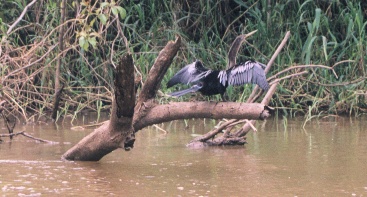6 October 2002: La Fortuna, Costa Rica
Subject: Costa Rica
Just time to write a few words about what we've done today.
We spent a night in Ciudad Quesada, which litterally means something like Cheesy City so not suprisingly the locals call it San Carlos instead. From there we came here to La Fortuna, a touristy place near Volcán Arenal. Arenal is a rather active volcano and you're supposed to be able to see red hot rocks and lava being ejected from the top and rolling down the slopes. When we arrived it was covered in cloud in it was pouring with rain, but still touts were trying to sell us US$25 trips to "see" the volcano. It's frustrating that you can get all the way here from San José by public bus for next to nothing, but the cheapest way to do the last 17km is to hire a bike. This evening the weather is clearer, and it might be possible to see some activity from the town later.
Caño Negro
This morning we took a tour to Caño Negro, a river wildlife area in the North, near the Nicaraguan border. After a drive to Los Chiles, during which we would occassionally stop to look at an interesting bird in a tree through our guide's telescope, we boarded a boat for a three-hour trip up the river.
From the boat we saw all sorts of wildlife: mostly birds, but also a few Caimans (should that be Caimen?), one turtle, a few sleeping bats, more sloths and monkeys including spider monkeys which we hadn't seen before, and plenty of butterflies and dragonflies. The most memorable bird was a Slaty-Tailed Trogon - a wonderfully colourful thing with lots of red that generously flew across the river right in front of the boat. There were several kinds of kingfisher that stayed still on branches long enough for us to look at them, and a couple of kinds of cormorant-like divers that we saw drying their wings in the sun. Then there were various kinds of swallow, egrets, and several kinds of heron. Maybe I'll try and write a proper list when I have Christine's wildlife guide with me, but half the things were too rare to be in it! This is an Anhinga, or "Ninga Ninga" as our guide called it - like cormorants they are rather primitive and don't have waterproof wings so they spend much of their time drying them out on branches like this.

That's all for now.